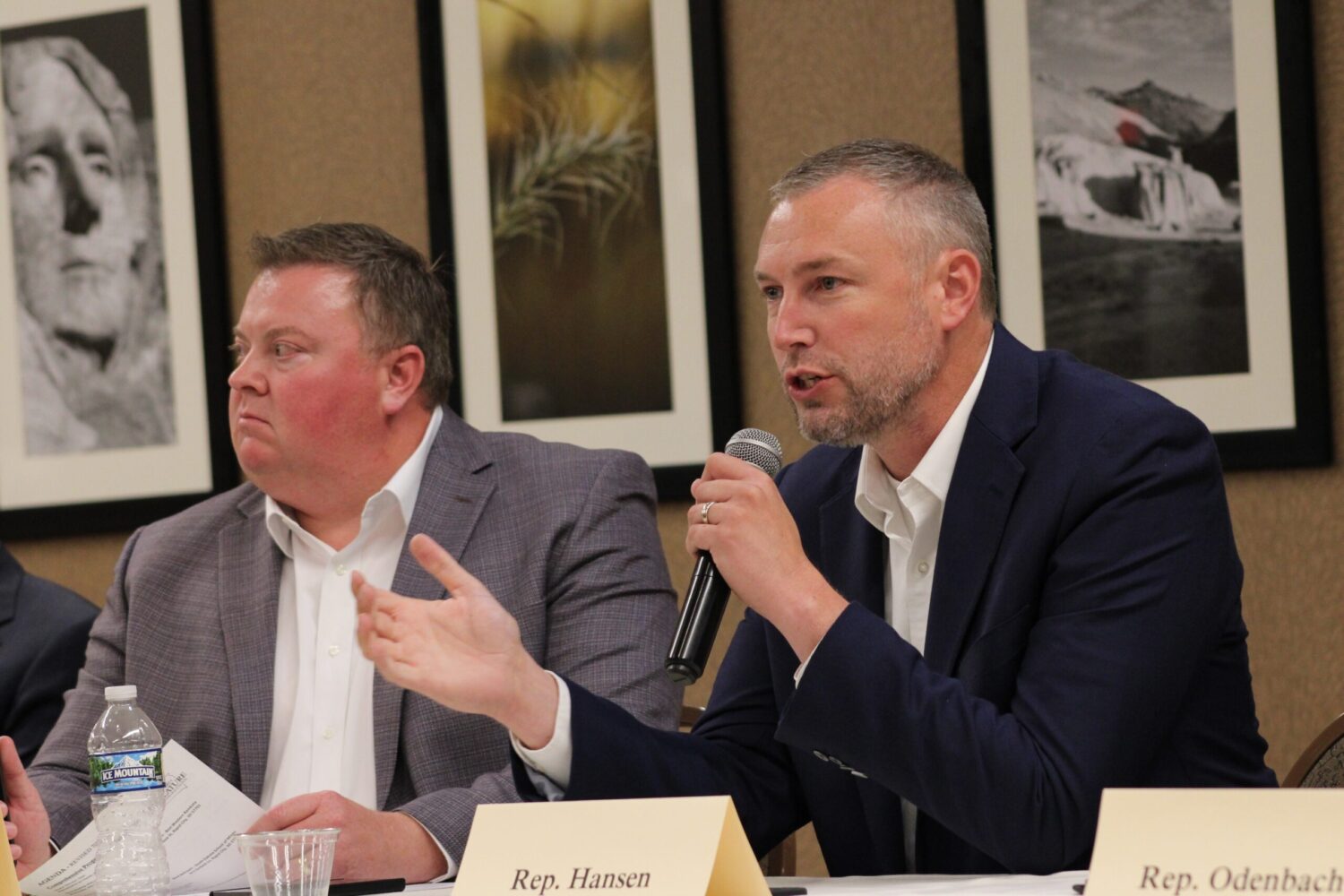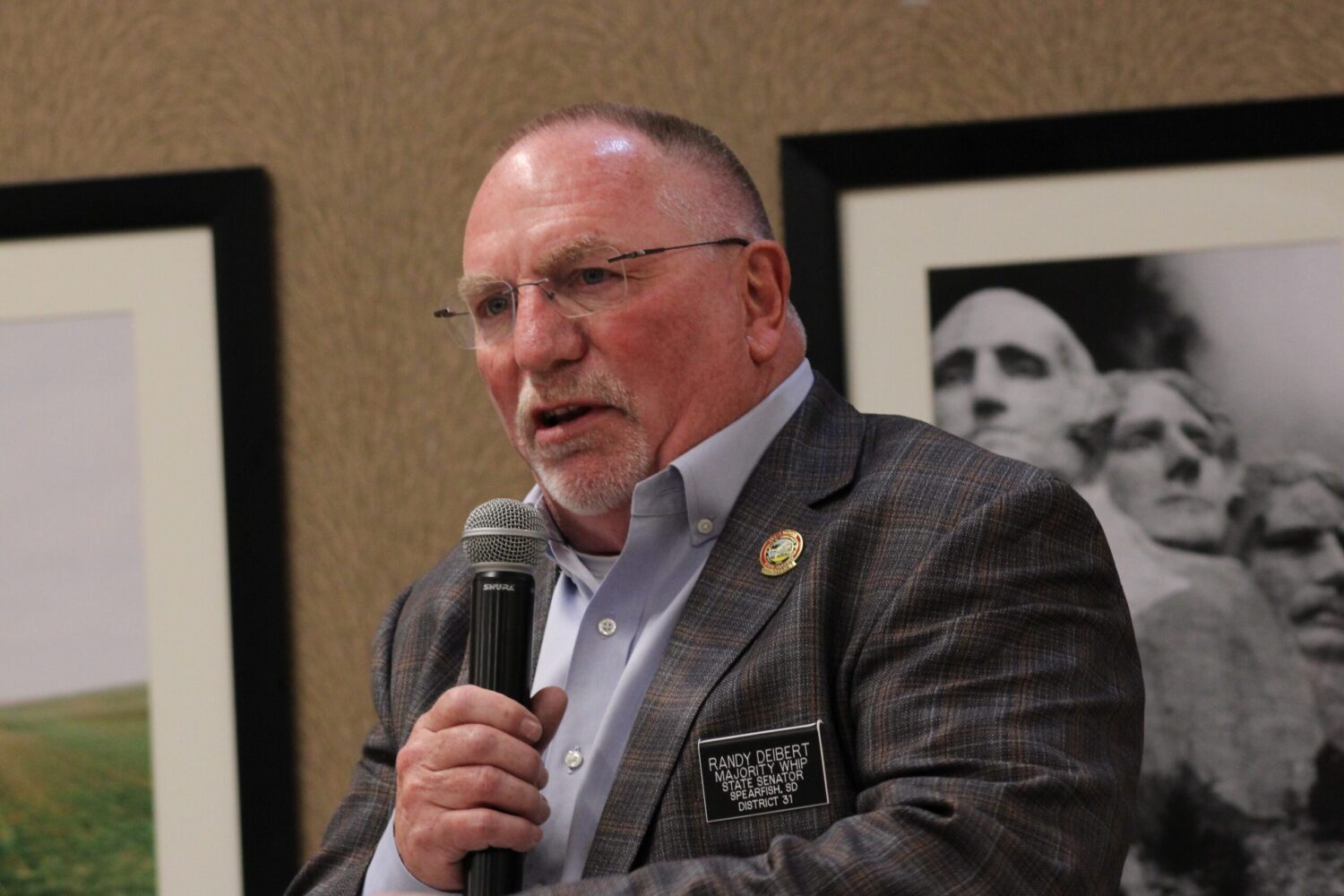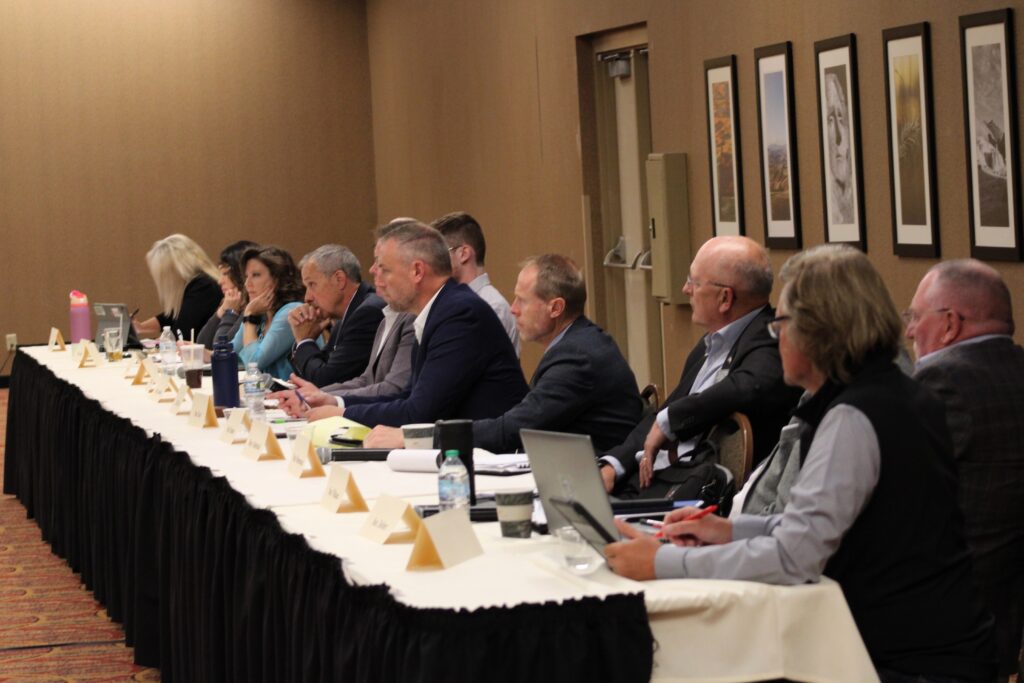Members of the South Dakota Legislature’s Comprehensive Property Tax Task Force meet on July 16, 2025, at the Ramkota in Rapid City. (Photo by Seth Tupper/South Dakota Searchlight)
The 19 proposals advanced on Wednesday by a legislative task force aiming to reduce property taxes for South Dakota homeowners are a mix of ideas including spending cuts, increases in other taxes and tapping into other funds.
In addition to recommendations by the task force, lawmakers will likely have to contend with other property tax proposals when they convene for the annual legislative session in January. That could include a revival of a state sales tax rate increase from 4.2% to 5% and the governor’s proposed optional half-percent sales tax for counties, which currently don’t have authority to tax sales (only the state and cities have that power).
Lawmakers on the task force expressed a hope in June to propose legislation that will significantly cut the average South Dakota homeowner’s property taxes. South Dakota property taxes paid by homeowners increased 38.8% between 2020 and 2024.
window.addEventListener(“message”, function(event) {
var message = JSON.parse(event.data);
if (message.sender == “Flourish” && message.context == “iframe.resize”) {
src = message.src.replace(/#.+$/, “”);
vizFrame = document.querySelector(‘iframe[src=”‘ + src + ‘”]’);
vizFrame.setAttribute(‘height’, message.height);
}
});
The proposals include cutting state spending and applying the savings to property tax relief, replacing some property tax revenue with sales tax increases, using one-time tax credits for temporary relief, and reserving a portion of future state revenue increases each year to reduce property taxes.
Chair of the task force and Senate President Pro Tempore Chris Karr, R-Sioux Falls, said details need to be hashed out with some of the proposals. Task force member and Sen. Randy Deibert, R-Spearfish, cautioned lawmakers at the end of the meeting.
“We need to be very careful about what we wish for,” Deibert said. “If we lower our property taxes so much, we’ll have more people moving here and have a big impact on that. We have to be very careful on that balance, to keep our quality of life and not be overrun by people moving here because we have such a great tax environment.”
Cut state spending by 5%
The most contentious proposal to make it through the task force is cutting state government general fund spending by 5%, or about $123 million — with cooperation from Gov. Larry Rhoden’s administration to identify where potential cuts could be made. The cuts themselves wouldn’t reduce property taxes, because the state doesn’t receive any property tax revenue (only counties, schools, cities and other local governments do). The state would have to dedicate the savings toward property tax relief.
Task force Vice Chair and House Speaker Jon Hansen, R-Dell Rapids, said the executive branch’s cooperation is needed to “cut state government in this fashion.”
“I think the fundamental reason for this request is because, if we want real tax relief, it must come from cuts to government spending,” said Hansen, who is running for governor next year. “Otherwise, we’re just shifting the burden onto other taxpayers.”
Other members of the task force and the public warned task force members against state cuts. Jim Terwilliger, commissioner of the South Dakota Bureau of Finance and Management, said many of the budget cuts proposed by the Rhoden administration for this fiscal year were unpopular with lawmakers, and some of them were restored.
“It’s pretty easy to say, ‘Oh, let’s go cut 5%,’” Terwilliger said, adding, “I think it’s going to be very, very difficult to do that at the end of the day.”
Reserve some future revenue growth for property tax relief
Another recommendation would create a new property tax relief fund by depositing 25% of the annual increase in ongoing state revenue into the fund each year.
The idea, proposed by Karr, would be a long-term investment in property tax relief, he said.
Sen. Taffy Howard, R-Rapid City, said it would be a new line item in the state budget and grow each year. Karr compared the idea to annual increases in state employee salaries, education and Medicaid reimbursements.
“Even with an average of 4% growth, we can have a significant buildup,” Karr said, adding, “Maybe this is the seed we plant for future growth in property tax relief.”
Sales tax increase used for property tax relief
The task force also advanced a proposal to use a sales tax increase from 4.2% to 4.5% to create a fund to replace a portion of property taxes collected by school districts. A temporary sales tax reduction from 4.5% to 4.2%, adopted in 2023, is already scheduled to expire in 2027 unless lawmakers make it permanent.
South Dakota Retailers Association Executive Director Nathan Sanderson encouraged lawmakers to support the idea, saying that his organization has been advocating for the “relatively simple” proposal since 2022.
One-time $500 tax credits
A $500 property tax credit for owner-occupied properties would be funded by remaining Housing and Infrastructure Financing program money and budget reserve funding, totaling $120 million.

Lawmakers used a combination of state and federal funding in 2023 to create a $200 million Housing and Infrastructure Financing program, meant to spur housing developments across South Dakota. Much of that money has been spent as grants, but just under $65 million in loans remain untouched. The Legislature earlier this year dipped into the fund to spend $15 million on a loan for the Douglas School District, serving the Ellsworth Air Force Base, to help build an elementary school.
Hansen proposed spending the remaining funds on property tax relief. On Friday, the governor unveiled a rival proposal to spend some of the the remaining housing infrastructure money on airport expansions in Sioux Falls and Rapid City.
Julie Johnson, a lobbyist who represents various housing groups, said many organizations have proposals in the works to use the remainder of the Housing and Infrastructure Financing money.
“I would urge your avoidance of that fund,” Johnson said. “It’s filled incredible niches in the housing infrastructure economy and allowed a lot of communities to take the next steps into building their own opportunities.”
Tax increment financing regulations
One of the most controversial proposals related to property taxes is Howard’s tax increment financing district regulation package.
Local tax increment financing districts provide upfront financing to build streets, water pipes and other infrastructure for development, while capturing the higher property taxes generated by the development to pay off the financing over time. TIFs, as they are known, have become controversial in some areas, including Rapid City, where critics including Howard allege they’ve become handouts for wealthy developers.

If passed, Howard’s proposal would restrict TIFs by reducing the percentage of a city or county’s overall assessed value that can be part of a TIF, requiring that at least 50% of the area within a proposed TIF district be blighted, redefining “blight,” requiring counties to approve TIF districts established by a city, requiring an independent evaluation that a project would not be built unless a TIF was established, and requiring a special election for TIF districts totaling $10 million or more.
Howard called the changes “common sense” as TIFs become a more commonly used tool, especially in urban counties, to “reign it back.”
Other task force members, including Deibert, were concerned the package is too restrictive and would harm communities. Deibert and other critics conceded that TIFs could be further regulated in the state, but without “punishing people who really need” them.
The impact of TIFs on local property taxpayers is a subject of debate, with critics saying the capturing of a project’s property taxes to pay off TIF financing temporarily burdens other taxpayers, while TIF proponents say TIFs spur development that broadens the tax base over time.
Other proposals
Other proposals advanced by the task force:
- Expanding the state’s property assessment freeze program income limit for older and disabled South Dakotans.
- Requiring counties to include a QR code on property tax bills to direct taxpayers to the state’s property tax website, in an effort to increase transparency about how property taxes are used.
- Setting school districts’ annual increase for property tax revenue at the same level as all other taxing districts, since school districts are currently exempt.
- Allowing property owners applying for tax relief programs to fill out forms online, rather than at the county office.
- Raising the minimum value of a new structure or addition that qualifies for the discretionary formula, a property tax incentive to promote economic development in the state, from $30,000 to $100,000.
- Creating a new fund directing all state lottery revenues to state aid for education, rather than placing the revenues into the state general fund.
- Prohibiting a school district from transferring money from its capital outlay fund to its general fund, as well as limiting annual increases in a school district’s capital outlay property taxes to 3% or inflation, whichever is less, and removing additional increases allowed from growth.
- Expanding the state’s property tax relief program for disabled veterans by increasing the maximum exempt assessed value to the entire assessed value of the property, and offering a refund of property taxes to eligible South Dakotans who qualify but did not apply in the last five years of eligibility.
- Allowing more cities to implement a property tax rebate program for owner-occupied properties, such as the one in Sioux Falls, which has such a program in place because it has a unique charter, called home rule, allowing more autonomy in its governance.
- Restricting school district opt outs (decisions to exceed state-imposed limits on property tax revenue growth), by making it easier to bring an opt out to a vote of the people by automatic referral, decreasing signature requirements for referral, requiring 60% approval, or increasing the number of days opponents have to gather petition signatures to force a referral.
- Creating a fund to replace a portion of property taxes collected by school districts, using any sources of revenue lawmakers put toward the fund.
GET THE MORNING HEADLINES.


